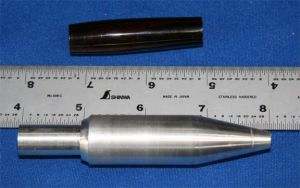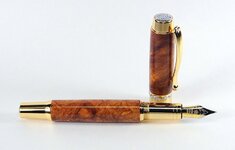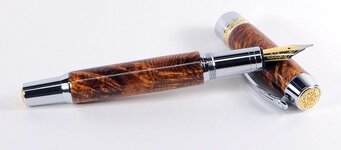A little history here:
When you are turning TBC without bushings,
60° centers are NOT necessary.
A 60° center IS necessary for
Mandrel Ends and With JohnnyCNC's bushings, and any bushings made FOR 60°. For general
bushings that are made for mandrels, it does not matter which centers are used on those bushings.
Back in '06 or '07, Frank aka "Rifleman" mentioned someone (on another forum?) using a rare term of turning without a mandrel. The first time he mentioned it, I wondered what in the world he was talking about. Then, a few weeks later, he mentioned it again. then, I had remembered Johnny CNC also mentioning this. (I was having trouble of separating bushings from the blank after finish - breaking and chipping the finish. Franks' reply was to this end.)
With that bit of information, I took 1 inch round piece of aluminum and turned a drive center. It was not 60° because it was fitting directly into the tubes. JohnnyCNC had not started making his 60° bushings at the time, so a "specific" degree° of the drive center or tail stock was/is not necessary UNLESS the receptor is of a specific degree.
Open holed bushings such as for a mandrel (unless chamfered for 60°) can take any drive or tail stock center. I don't remember who it was but they turned wood to use as the drive center. The angle/degree was not necessary except to fit into the hole.
Below is the picture of the drive center that I made that started the TBC movement after JohnnyCNC and Rifleman's initial comments:
 View in Gallery
View in Gallery
It is obvious that this is not 60°. A 60° center IS necessary ONLY when the receptor is 60°. BTW, I did not use that initial drive with "made for mandrel" bushings as it was still too fat on the end and I discovered that aluminum was too soft. Soon after that picture was taken, I ordered a 60° drive center and started using that - I used it with "mandrel bushings".
I will add that I was very finicky about bushings. I lived in Japan at the time and there was a big time delay and expensive in receiving things from the USA. About 1 in 4 or 1 in 5 "mandrel bushings" were not made to good tolerances. It was acceptable by most but caused enough "out of whack" that JohnnyCNC started his bushing business along with a few others. Johnny made his bushings for the 60° centers. At that point, the 60° became the standard. But again, if using an open holed bushing made for mandrels is used, the degree of drive does not matter.
If anyone wishes to do searches, back at that time, I used the term "mandrelless" or "mandreless."
 I figured it's as good a subject for trying to turn "by caliper" as any other, so I'm here asking for tips on how to turn without bushings. Courtesy of the wondrously informative reference listing, I know what dimensions I need, so at least that part is sorted out.
I figured it's as good a subject for trying to turn "by caliper" as any other, so I'm here asking for tips on how to turn without bushings. Courtesy of the wondrously informative reference listing, I know what dimensions I need, so at least that part is sorted out.


